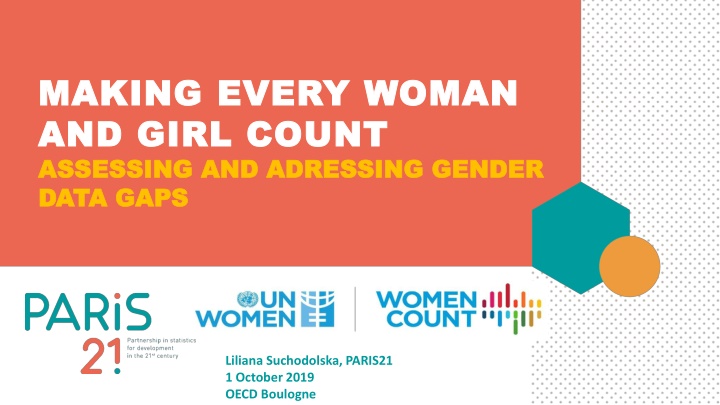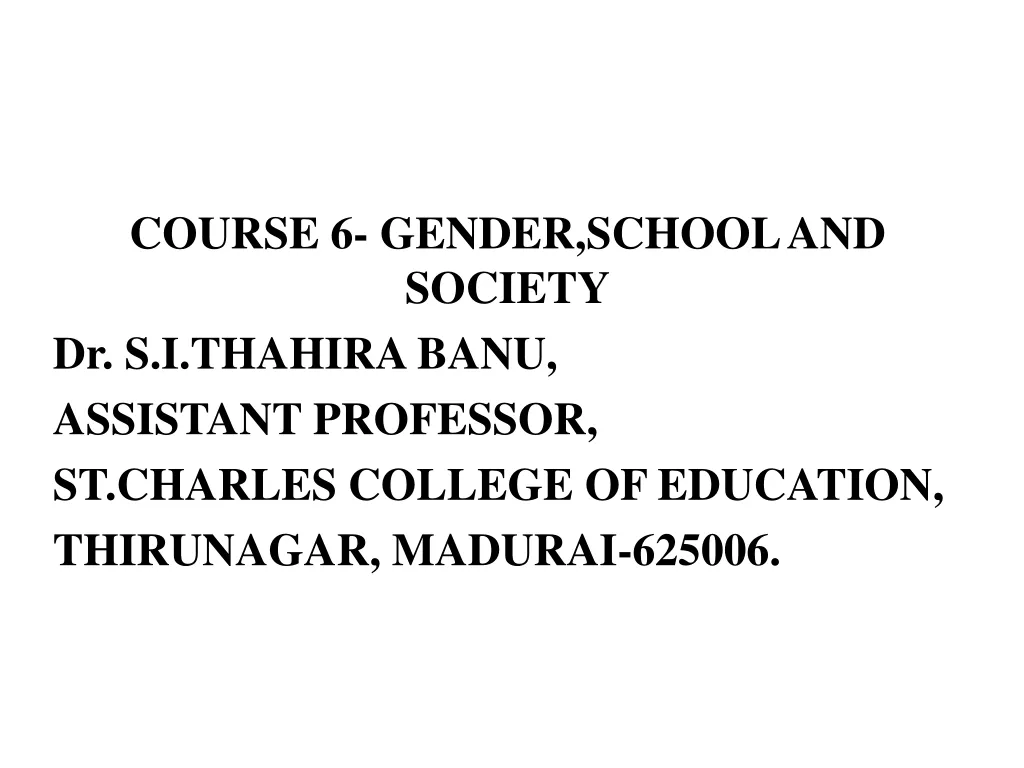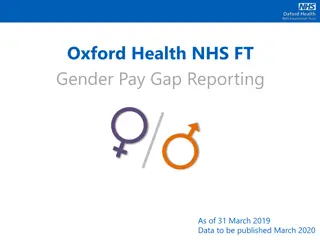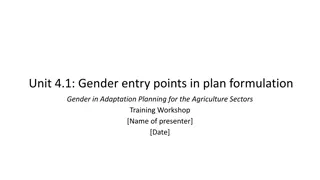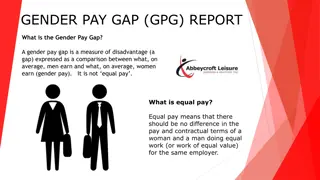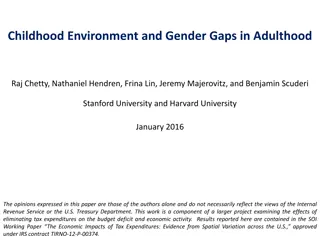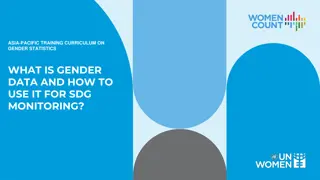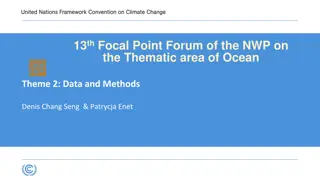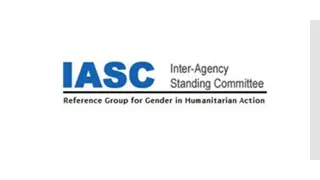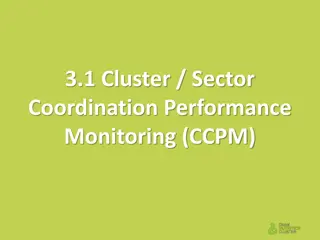Addressing Gender Data Gaps and Improving Coordination in Global Data Collection
Framework and guidelines developed to assess gender data and capacity gaps, with a focus on cooperation between Paris21 and UN Women. The initiative aims to enhance statistical planning and optimize data collection processes to ensure every woman and girl is counted. Through global mandates and regional initiatives, the program seeks to bridge existing gaps in gender statistics and advocate for improved data quality worldwide.
Download Presentation

Please find below an Image/Link to download the presentation.
The content on the website is provided AS IS for your information and personal use only. It may not be sold, licensed, or shared on other websites without obtaining consent from the author.If you encounter any issues during the download, it is possible that the publisher has removed the file from their server.
You are allowed to download the files provided on this website for personal or commercial use, subject to the condition that they are used lawfully. All files are the property of their respective owners.
The content on the website is provided AS IS for your information and personal use only. It may not be sold, licensed, or shared on other websites without obtaining consent from the author.
E N D
Presentation Transcript
MAKING EVERY WOMAN MAKING EVERY WOMAN AND GIRL COUNT AND GIRL COUNT ASSESSING AND ADRESSING GENDER ASSESSING AND ADRESSING GENDER DATA GAPS DATA GAPS Liliana Suchodolska, PARIS21 1 October 2019 OECD Boulogne
2 COOPERATION PARIS21 COOPERATION PARIS21- -UN WOMEN UN WOMEN IMPROVING CO IMPROVING CO- -ORDINATION AND PLANNING IN COUNTRIES AND PLANNING IN COUNTRIES OF GLOBAL SOUTH OF GLOBAL SOUTH ORDINATION Framework and Implementation Guidelines to assess data and capacity gaps related to gender statistics
3 OUTLINE OUTLINE 1. Context and rationale 2. Value added 3. How it works? 4. Main actors and steps 5. Expected outcomes
4 CONTEXT CONTEXT AND RATIONALE AND RATIONALE Global and regional mandates: IAEG-GS review in 2012, UNECE assessment of SDGs readiness Sectoral and institutional initiatives ESCWA Framework for Developing National Gender Statistics Programmes (2016) FAO Agri-Gender Statistics Toolkit (2017) ADB Gender Assessment of 10 Countries (Southern Caucasus, Central and West Asia, 2012) To guide project development and implementation UN Women s Women Count Programme (as a prerequisite for project development) Increased advocacy and awareness raising SDG5 and Leave No One Behind Data gaps: Only 14 of 54 gender-specific SDG indicators have sufficient and regular data And capacity gaps: Only 13% of countries dedicate a budget to gender statistics (2013 Report of the Secretary-General on Gender Statistics) Need for optimisation: Existing assessment varied significantly from country to country, duplication (waste of resources and assessment fatigue), no links to long-term statistical planning.
5 DEVELOPMENT OF THE FRAMEWORK DEVELOPMENT OF THE FRAMEWORK Review committee consisted of experts from: Countries (3) National Statistics Institute of Chile, Statistics Finland, Uganda Bureau of Statistics International agencies (6) - UN Women, UNESCAP, UNESCWA, UNECE, World Bank, OECD Other partners of the international statistical community (4) Global Centre of Excellence on Gender Statistics, Open Data Watch, Data2X, Royal Statistical Society Development process: First draft developed in 2018, piloted in Dominican Republic and Maldives (March-April 2019) Second draft (July 2019), piloted in Senegal (August 2019) and Kyrgyz Republic (September 2019) Continued refinements in 2019 and 2020 Final assessment framework and guidelines in 2020
6 VALUE ADDED VALUE ADDED Comprehensive, granular and holistic approach to the capacity of the national statistical system Embedded in the NSDS process (National Strategy for Development of Statistics): political weight, the endorsement and active participation of decision makers Assessments based on country ownership, multi-stakeholder approach and long-term solutions Devotes special attention to the use and users of gender statistics
HOW HOW IT IT WORKS WORKS? ?
8 Main assessment tools and milestones Main assessment tools and milestones 1. Assessing statistics gaps Framework of indicators Data planning 3. Assessment report = basis for NSDS-gender strategies 2. Assessing NSS capacity gaps Questionnaire A Questionnaire B Questionnaire C Questionnaire D
9 ASSESSING DATA GAPS ASSESSING DATA GAPS Data planning tool ADAPT: A free cloud-based application managed by the NSOs Allows NSOs and ministries in charge of gender to see all gender-specific data being produced across the different agencies in the national statistical system. Maps gender statistics demand from global and national policies with the existing supply of indicators to identify consistency, alignment, and possible overlaps. Provides a detailed look into data gaps to monitor the SDGs and other policies relevant to gender equality: sources, institutions, feasibility. Facilitates optimization: helps solve duplications and redundancies
10 ASSESSING CAPACITY GAPS: CD4.0 ASSESSING CAPACITY GAPS: CD4.0 Resources, Skills & Knowledge, Management, Politics & Power, Incentives SYSTEM Resources, Skills & Knowledge, Management, Politics & Power, Incentives ORGANI- SATION Resources, Skills & Knowledge, Management, Politics & Power, Incentives INDIVIDUAL
11 ASSESSING CAPACITY GAPS: CD4.0 ASSESSING CAPACITY GAPS: CD4.0
12 ASSESSING CAPACITY GAPS ASSESSING CAPACITY GAPS We apply four questionnaires assessing different capacities, designed for different national stakeholders and data users in the country: Questionnaire A main assessment tool: organisational and systemic level of the CD4.0 (80+ questions) Questionnaire B short module: CD4.0 individual level Questionnaire C short module: non-NSO agencies producing statistics Questionnaire D short module: users of statistics (can be used as an online survey)
13 ASSESSMENT STEPS AND ACTORS ASSESSMENT STEPS AND ACTORS Assessment Integrating gender in NSDS Statistical capacity gaps Data gaps Inception workshop Validation workshop All stakeholders All stakeholders Data-planning expert from NSO NSDS focal person Gender-statistics expert
14 DETAILED ASSESSMENT STEPS DETAILED ASSESSMENT STEPS 1. Collection and review of relevant documents 3. Data planning (ADAPT) 4. Consultation with stakeholders 2. Inception workshop 6. Draft assessment report 5. 7. Validation of findings Consolidation of the findings 8. Final assessment report 11. Development of strategies for NSDS 10. 9. Validation workshop Dissemination of results
15 KEY ASSESSMENT ACTORS KEY ASSESSMENT ACTORS Gender statistics expert Focal persons: NSO gender unit ministry of women/gender line ministries NSDS coordinator Data planning expert Heads of involved institutions Users of statistics Good practice: Inter-agency group on gender statistics
16 EXPECTED RESULTS: EXPECTED RESULTS: Accurate assessment of gender statistics at the country level = basis for the National Strategy for Development of Gender Statistics Integration of GS in the overall data planning of the NSO Improved coordination of gender statistics production through: National Inter-Agency Group on Gender Statistics TIMING: TIMING: Approximately 6 months (depending on many factors: existence of priority frameworks of indicators, identification of the gender statistics expert, availability of stakeholders...)
17 National Strategy for Development of Gender Statistics - Informed by the assessment results and a special workshop for designing strategies; - Elaborated by and expert in cooperation with the NSDS coordiantor - Gender-specific sectoral strategy + Gender has to be integrated also in other sectors: education, health, etc. - PARIS21 designs guidelines for development of Gender-NSDS Q4 2020.
18 PILOT COUNTRIES PILOT COUNTRIES 2019 2019/2020 COUNTRY STATUS COUNTRY STATUS Dominican Republic On-going Jordan Confirmed 9 countries over 2019-2020 Bolivia Maldives On-going Confirmed Senegal On-going Cambodia Confirmed Egypt On-going Rwanda Pending Kyrgyz Republic On-going
THANK YOU THANK YOU https://paris21.org/
